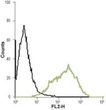Prokr1 Rabbit Polyclonal Antibody
Other products for "Prokr1"
Specifications
| Product Data | |
| Applications | FC, IHC, WB |
| Recommended Dilution | WB: 1:200-1:2000; IHC: 1:100-1:3,000; FC: 1:50-1:600 |
| Reactivities | Mouse, Rat |
| Host | Rabbit |
| Clonality | Polyclonal |
| Immunogen | Peptide (C)ENTTNTFTDFFSARD, corresponding to amino acid residues 10-24 of rat Prokineticin receptor 1. Extracellular, N-terminus. |
| Formulation | Lyophilized. Concentration before lyophilization ~0.8mg/ml (lot dependent, please refer to CoA along with shipment for actual concentration). Buffer before lyophilization: Phosphate buffered saline (PBS), pH 7.4, 1% BSA, 0.025% NaN3. |
| Purification | Affinity purified on immobilized antigen. |
| Conjugation | Unconjugated |
| Storage | Store at -20°C as received. |
| Stability | Stable for 12 months from date of receipt. |
| Gene Name | prokineticin receptor 1 |
| Database Link | |
| Background | The Prokineticins (PK1 and PK2) are a pair of cysteine-rich secreted peptides with broad physiological functions including gastrointestinal motility, angiogenesis, hematopoiesis and circadian rhythms regulation. The biological effects of the PK1 and PK2 are mediated by two highly homologous receptors termed Prokineticin Receptor 1 (PKR1) and Prokineticin Receptor 2 (PKR2) that belong to the 7-transmembrane domain, G protein-coupled receptor (GPCR) superfamily. Both PK ligands activate the two PK receptors with similar potency. PKR1 receptors couple to Gq/G11 proteins leading to phospholipase C activation, inositol phosphate production and calcium mobilization. In addition, activation of the mitogen-activated protein kinase (MAPK) pathways has also been described. PKR1 is broadly distributed throughout peripheral tissues including the intestinal tract, testis, uterus, lung and peripheral blood leukocytes. In addition, the receptor is expressed in the brain particularly in olfactory regions as well as in dorsal root ganglion (DRG) neurons. The physiological function of PKR1 is still being elucidated, however, evidence suggest that the receptor has an important role in pain perception through its ability to stimulate the TRPV1 ion channel in DRG neurons. In addition, a role for PKR1 in the control of the inflammatory response through regulation of macrophage chemotaxis and cytokine production has also been demonstrated.3 |
| Synonyms | GPR73; GPR73a; OTTHUMP00000159967; PK-R1; PKR1; ZAQ |
| Reference Data | |
Documents
| Product Manuals |
| FAQs |
{0} Product Review(s)
0 Product Review(s)
Submit review
Be the first one to submit a review
Product Citations
*Delivery time may vary from web posted schedule. Occasional delays may occur due to unforeseen
complexities in the preparation of your product. International customers may expect an additional 1-2 weeks
in shipping.






























































































































































































































































 Germany
Germany
 Japan
Japan
 United Kingdom
United Kingdom
 China
China







